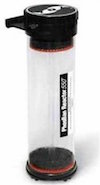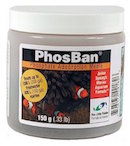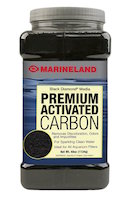High phosphate levels encourage agressive, weedy algae growth, and reduce calcium in your tank water. Reduction of calcium stunts the growth of coral, desirable algae, and snails. This means your reef tank will not thrive when in conditions of high phosphate. Phosphate reactors suck in water through a tube attached to your tank. They pump water slowly upwards, through a substance known as granular ferric oxide. This reacts with phosphate, eliminates it, and promotes calcium growth in your tank. Water is pumped back into your tank with much less phosphate, and even some calcium. Phosphate reactors can also be used effectively with other chemical substances such as activated carbon. Activated carbon removes odors and discoloration from your tank water, yielding in crystal clear water.
Two Little Fishies Phosban Reactor
Phosban is a a brand name for GFO, Granular Ferric Oxide; rust. GFO is used in chemical filtration systems as a means to remove phosphate as well as stabilizing levels of copper, cobalt, zinc, manganese in your tank water. Phosphates are a by-product of excess fish food. High levels subdue calcium levels and calcification. Calcification is when carbonate ions and calcium ions combine to form calcium carbonate. This nutrient is crucial to the growth of coral, coralline algae, and snails. When this nutrient is depleted, your reef tank suffers from stunted-growth. A phosphate reactor is a great addition to any tank as it utilizes GFO to diminish phosphate levels so that your tank can thrive. Phosphate reactors can be used for phosban, activated carbon, and other supplements. To set up this device, attach tubing from the reactor to a pump in your sump, and attach tubing to the other spot to allow the water to flow back into your tank. The proper flow rate for these devices is between 20 and 30 gph. Fill the reactor one-third full with phosban. Turn the pump on a low speed to activate the reactor. The water will flow down the middle tube, flow out of the bottom, and slowly, in a liquidized manner, flow upwards in the phosban and past the media filter. The phosphates react with the iron molecules in the phosban, and create a increased pH. the increased pH encourages precipitation of calcium carbonate on the surface of the filter media. The phosphates are now gone, calcification is increased, and corals and snails are happy, healthy, and blooming with growth.
| Two Little Fishies Phosphate Reactor | Phosban | Activated Carbon |
 |
 |
 |
| View on Amazon Model 150Model 550 |
View On Amazon 150g 454g |
View On Amazon 5, 10, 22, and 40 ounce |